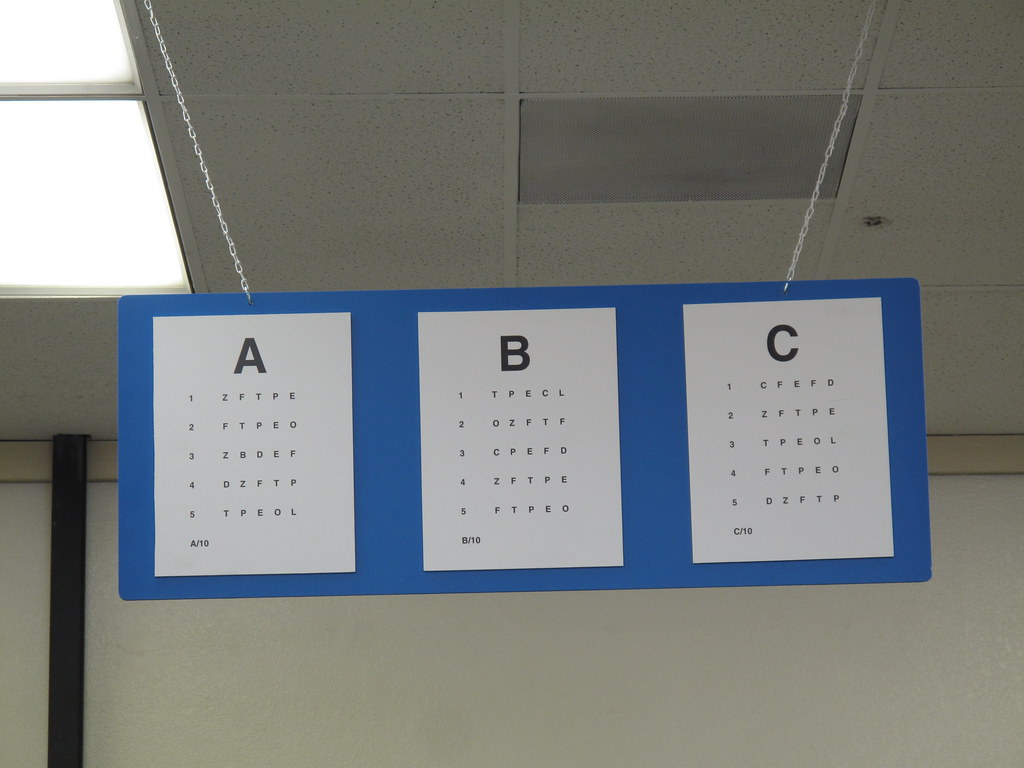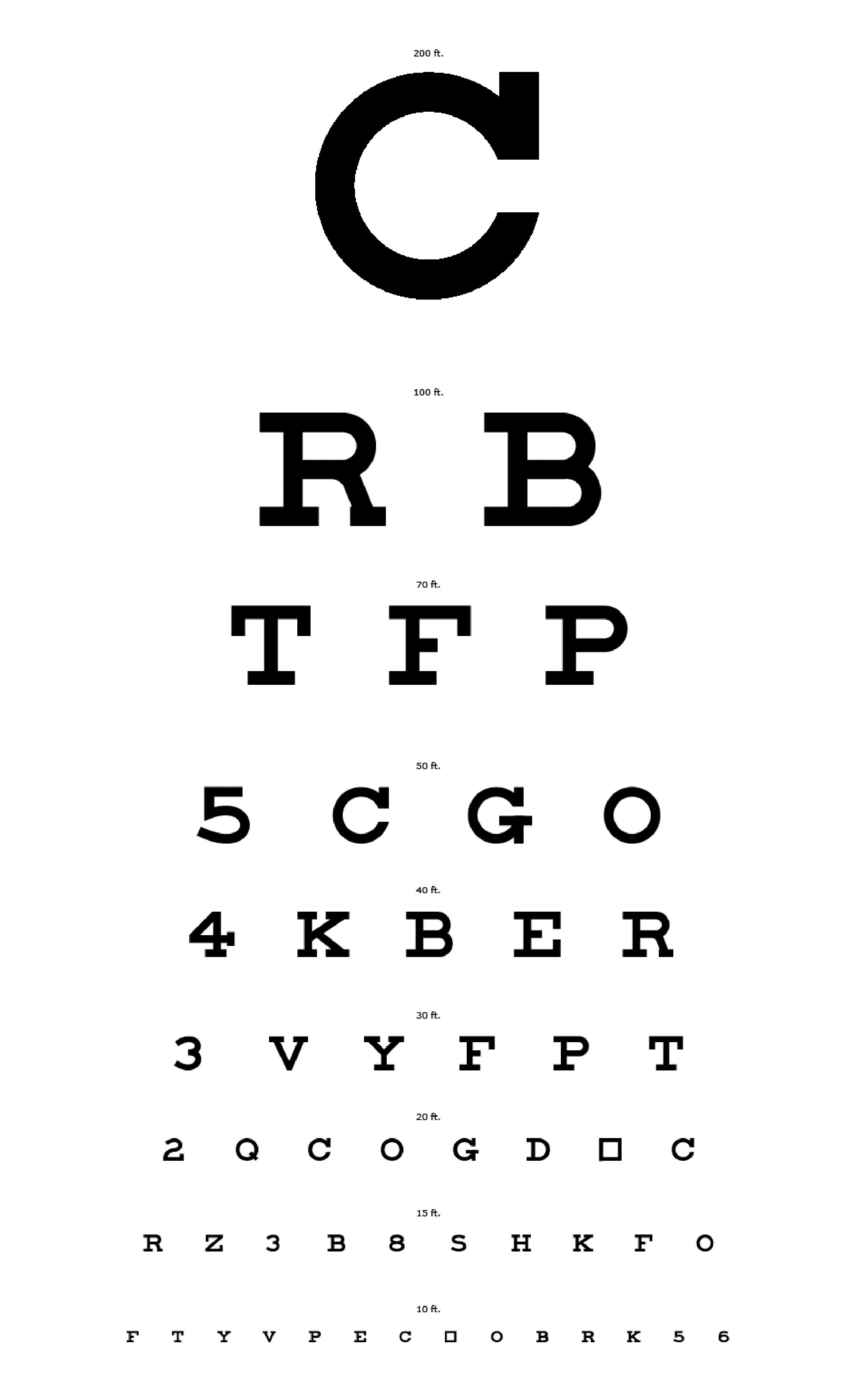When it comes to taking care of our eyesight, staying on top of regular check-ups and tests is incredibly important. One of the most common tests that we are required to take is the eye chart test, which is performed to evaluate the sharpness and clarity of our vision. In this post, we will be exploring the topic of eye charts, sharing different examples of eye charts, and discussing why they are important.
Eye Chart #1
 The first eye chart we will be looking at is the Kaplan eye chart. This eye chart is one of the most commonly used charts in optometrists’ offices and clinics. It features 11 rows of letters in decreasing size, with the first row being the largest and the last row being the smallest. Patients are asked to stand a certain distance away from the chart and read the letters that they can see without squinting or straining their eyes.
The first eye chart we will be looking at is the Kaplan eye chart. This eye chart is one of the most commonly used charts in optometrists’ offices and clinics. It features 11 rows of letters in decreasing size, with the first row being the largest and the last row being the smallest. Patients are asked to stand a certain distance away from the chart and read the letters that they can see without squinting or straining their eyes.
Eye Chart #2
 This next eye chart is a little different from the first. Instead of using letters, it uses pictures of different sized chickens. The idea behind this chart is to make it applicable to people who may not be able to read letters or who speak a different language. Patients are asked to identify the size and shape of the chicken they see.
This next eye chart is a little different from the first. Instead of using letters, it uses pictures of different sized chickens. The idea behind this chart is to make it applicable to people who may not be able to read letters or who speak a different language. Patients are asked to identify the size and shape of the chicken they see.
Eye Chart #3
 In this next example, we have a unique take on an eye chart. Instead of providing patients with letters or pictures to memorize, this chart encourages them to write about any topic they choose. Patients are given a pen and a sheet of paper and are asked to write out their thoughts. This test is used to evaluate patients’ ability to focus and read beyond the first few lines or rows of a chart.
In this next example, we have a unique take on an eye chart. Instead of providing patients with letters or pictures to memorize, this chart encourages them to write about any topic they choose. Patients are given a pen and a sheet of paper and are asked to write out their thoughts. This test is used to evaluate patients’ ability to focus and read beyond the first few lines or rows of a chart.
Eye Chart #4
 The next eye chart on our list is the Missouri Drivers License Vision Test. This eye chart, like most state-issued driver’s license tests, is used to evaluate the vision of drivers. It features a series of letters and numbers in varying sizes, and drivers are required to read the smallest line they can see from a distance of 20 feet away. If their vision falls below a certain threshold, they may be required to wear corrective lenses while driving or may have their license restricted.
The next eye chart on our list is the Missouri Drivers License Vision Test. This eye chart, like most state-issued driver’s license tests, is used to evaluate the vision of drivers. It features a series of letters and numbers in varying sizes, and drivers are required to read the smallest line they can see from a distance of 20 feet away. If their vision falls below a certain threshold, they may be required to wear corrective lenses while driving or may have their license restricted.
Eye Chart #5
 The fifth eye chart we will be discussing is the DMV Eye Chart for 2015. Many states require drivers to take a vision test when renewing their license, and the DMV eye chart is one of the most commonly used. It features 11 lines of letters in decreasing size, with the first line being the largest and the last being the smallest. Similarly to other vision tests, drivers are required to read the smallest line they can see from a distance of 20 feet or more.
The fifth eye chart we will be discussing is the DMV Eye Chart for 2015. Many states require drivers to take a vision test when renewing their license, and the DMV eye chart is one of the most commonly used. It features 11 lines of letters in decreasing size, with the first line being the largest and the last being the smallest. Similarly to other vision tests, drivers are required to read the smallest line they can see from a distance of 20 feet or more.
Eye Chart #6
 This next eye chart may look familiar to some of you. It features a series of letters in different sizes, with the large “E” at the top. This chart is one of the most commonly recognized eye charts and is typically used in schools or for vision screening programs. The letters on the chart are standardized, making it easier for doctors and optometrists to evaluate patients consistently.
This next eye chart may look familiar to some of you. It features a series of letters in different sizes, with the large “E” at the top. This chart is one of the most commonly recognized eye charts and is typically used in schools or for vision screening programs. The letters on the chart are standardized, making it easier for doctors and optometrists to evaluate patients consistently.
Eye Chart #7
 In this next example, we have another DMV eye chart. This chart is unique in that it is specifically designed for drivers who are renewing their license. It features a series of lines and letters in varying sizes, and drivers are required to read the smallest line they can see from a distance of 20 feet or more.
In this next example, we have another DMV eye chart. This chart is unique in that it is specifically designed for drivers who are renewing their license. It features a series of lines and letters in varying sizes, and drivers are required to read the smallest line they can see from a distance of 20 feet or more.
Eye Chart #8
 Another DMV eye chart on our list is the DMV Eye Test for NY Driver License Renewal. This chart is used in New York state to evaluate the vision of drivers renewing their license. Similarly to other DMV eye charts, it features a series of letters and numbers in decreasing sizes, with drivers being required to read the smallest line possible from a distance of 20 feet or more.
Another DMV eye chart on our list is the DMV Eye Test for NY Driver License Renewal. This chart is used in New York state to evaluate the vision of drivers renewing their license. Similarly to other DMV eye charts, it features a series of letters and numbers in decreasing sizes, with drivers being required to read the smallest line possible from a distance of 20 feet or more.
Eye Chart #9
 The final eye chart on our list is the Dmv Eye Test Chart Distance. This chart is used to evaluate the ability of patients to discern letters and numbers at a distance. It features 11 rows of letters and numbers in decreasing sizes, with patients being required to read the smallest line possible from a distance of 20 feet or more.
The final eye chart on our list is the Dmv Eye Test Chart Distance. This chart is used to evaluate the ability of patients to discern letters and numbers at a distance. It features 11 rows of letters and numbers in decreasing sizes, with patients being required to read the smallest line possible from a distance of 20 feet or more.
We have shared a variety of different eye charts in this post, each with its own unique purpose and design. While it may seem like a simple test, the eye chart is incredibly important in ensuring that our vision is in top shape. Regular eye exams and tests can help detect any potential issues early on, giving us the best chance at maintaining good eye health. So next time you visit your optometrist or take a driver’s license test, take a closer look at the eye chart. It may seem familiar, but it plays a crucial role in keeping your eyesight sharp and clear.